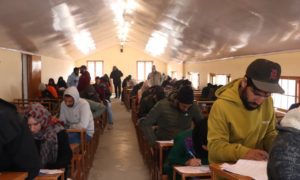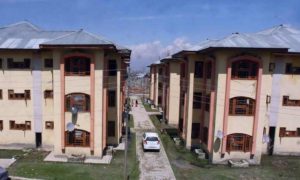To crystallize the memory of the first militancy-era massacre, a youth erected a memorial stone at Basant Bagh. Years later, after he himself became a conflict casualty, a memorial stone was erected for him on the same spot.
For years now, passersby see the two memorial stones weathering in the bustling Basant Bagh in Srinagar. Despite turning heads around, not many seem to have an idea how a single thread binds the two engraved stones: Showkat Ahmad Khan, the slain Samaritan who erected one memorial stone in remembrance of Gaw Kadal massacre, only to become the reason for the other years later.
“By hanging their heads, spilling their blood on the ground in way of truth; by saving the country’s garden, you raised the dignity of Muslims,” reads the memorial erected by Khan. “[This stone is] a tribute to 21 January 1990 in Gaw Kadal, Basant Bagh martyrs who gave their lives for their beloved country.”
The memorial stone came up at Shaheed Road, Gaw Kadal, Basant Bagh, years after the massacre, changing Khan and Kashmir.

FPK Photo/Furqan Khurshid
At his birth place, Basant Bagh, Khan aka Nana is recalled as a tall, well-built, well-mannered and sentimental guy who became a conflict casualty.
“Clean by heart, he would clean the alleys of his locality, believing that Cleanliness is next to Godliness,” a neighbour describes him.
ALSO READ: Of Migration and Nostalgia: A Kashmiri Pandit girl’s homecoming hues
Khan’s immediate family has long shifted from Basant Bagh to Nowgam’s Chiralipora area. The hasty move years ago was meant to evade the nightmarish nocturnal raids.
At his new address, his old mother Atiqa sits exactly at the spot where she had last seen him. A smile on her toothless mouth, a face full of wrinkles and moist eyes, speak volumes about how she feels.

Khan’s mother Atiqa. FPK Photo/Furqan Khurshid
“He was extremely sensible and kind,” the mother says. “He had studied up to Class 10th in ‘Zabri Zatch’ school.”
Laughing over and adoring her innocence, Mehjabeen, Khan’s sister-in-law, breaks in, “She doesn’t remember the details. You ask her, when he was born, she’ll say, that day it had snowed.”
Soon after the bridge butchery, Khan left home on the pretext of visiting Handwara for 10 days. He had instead gone for militant training along with other boys and returned three long months later as a Jammu Kashmir Liberation Front (JKLF) militant.
ALSO READ: The day before the Gaw Kadal Massacre: What happened inside cordoned Chota Bazaar?
On his return, Mehjabeen says, Khan established the memorial stone in the name of Gaw Kadal martyrs on the piece of land owned by his father Ghulam Rasool Khan, a prosperous transporter owning a fleet of private buses. The land was meant for business.
“But he would say: The martyrs deserve to be remembered. That’s the least we can do,” Mehjabeen says.
Once back from the training, Khan stayed a militant for about eight years, during which he was arrested, jailed and released many times.

Showkat Ahmad Khan. FPK Photo/Furqan Khurshid
“Rangreth police station, Central Jail, Papa1, Papa2: he had been taken to all these horrific places,” his sister-in-law continues. “At times, we had to pay the Border Security Force (BSF) men money to secure his release.”
Inside the Rangreth Police Station one day, she says, a fistfight broke out. Later around six boys escaped from the jail. Khan was one among them. Once back home, he decided to quit the militancy and got married. He opened a shuttering shop exactly near the memorial stone.
Then one day Maisuma’s Akhada Building was attacked in which two BSF men were killed. Someone had spread a word that Khan was seen running away from the spot with a gun. But both Mehjabeen and Atiqa say: “He was home that day.”
ALSO READ: Jagmohan: He came as a ‘nurse’, but…
Once the “rumour” spread, the armed forces began raiding his residence, forcing his family to shift to Nowgam. After a brief respite from raids, Khan was dragged out of his new residence and taken away on March 12, 2000.
“He never returned,” Mehjabeen laments. “That day he had come home, taken bath, offered namaz, recited Quran and was playing with his three-month-old daughter Aqsa when suddenly the forces cordoned off our place with the help of one informer Fayaz.” Before being dragged out, Khan would tell his family that he hadn’t killed any BSF men and that he was being made scapegoat for his militant past.
After his detention, the family went mad searching for him in every camp. He was nowhere to be found, until one day a man approached them saying, ‘His dead body has been found at Parimpora.’
ALSO READ: An Indian scholar from Cambridge maps the massacre at Gaw Kadal
Before being buried in Eidgah Martyrs’ Graveyard, the family saw his tortured body. “He was shot in the face in execution-style,” cries Mehjabeen. “I did not dare to see him.” Since then, his mother Atiqa’s heart sinks when she thinks about him. She mostly stays outdoors and visits shrines. “My chest burns. It’s all painful. I feel suffocated here. This place reminds me of him. I prefer to go to shrines and pray,” says Atiqa.

FPK Photo/Furqan Khurshid
On the other side, Khan’s daughter Aqsa knows little about who her father was. Her mother was remarried in her childhood. Knowing Mehjabeen as her mother, she recently passed her Class 12 and visited the Hurriyat leaders to support her education. “They have a Hurriyat quota in medical seats,” Mehjabeen says. “We requested them to keep a seat for Aqsa, who has passed with good grades. But nobody cares for a martyr.”
Amid this indifference, today Khan’s memory is a community tap and a memorial stone.
People who stop at the tap to quench their thirst often walk away reading a stark and ironic message on his memorial stone: “Sarfaroshi ki Tammanna ab hamaray dil mai hai / Dekhna hai zorr kitna baazu-e-qatil main hai” (The desire for sacrifice is now in our hearts/ We shall now see what strength there is in the boughs of the enemy).
Like this story? Producing quality journalism costs. Make a Donation & help keep our work going.












